Arnold Schoenberg is generally seen as the composer who did to music what Jackson Pollock was to do to art. Discard the old rules and take it into new realms, psychological and emotional planes hitherto unexplored, or unrepresented in that fashion.He was a troubled artist in a troubling time. A divisive figure, he was tearing away at established music in a traditional world that was tearing from its moorings. It was the development of an avant-garde that would never be popular; perhaps through lack of poetry, but then the pain it represents lacks a poetic center in which to wax.
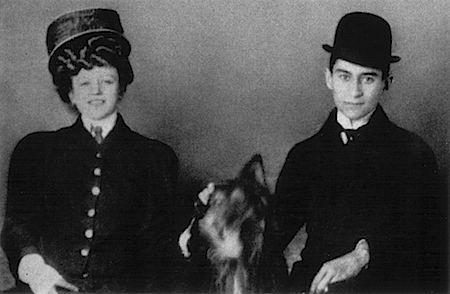
Alice herz-Sommer with kafka. "When I was young it was definitely Schumann. He is just adorable. Now I am older I love Beethoven and Schubert. Beethoven – because his music is deeply human and universal, and it represents endlessness. And Schubert, because his music makes you feel you are talking to God. Do you still play the piano? Every day! For almost 100 years. Despite my two crippled fingers I will keep playing until my last hour." Read More:
Was Schoenberg’s art some sort of joke: “Picasso once said that every good work of art is a kind of joke. Diego Rivera, the revolutionary Mexican muralist, agreed. Every piece of worthwhile art, properly understood, is not only like a joke, it is shocking. It must connect its elements in a new way; the world comes to be seen in a new way. A punch line of a joke may get a laugh, or perhaps only a smile. A first view of a great work of art may make one smile, more likely not. But it will be shocking, often without the viewer knowing quite why. “So art may not be a joke,” Rivera said, “but it is always like one.”–Read More: http://www.analysis.com/vs/vs85.html …How was “The Moses of Michelangelo” a joke for Freud? It was a private joke, not to be shared. My guess is that despite the worry and pain, he finally prevailed and saw into his fascination: once more he had been doing and undoing the murder of little Julius — a magical infantile fratricide which fronted for fantasies of two others, the crimes of patricide and filicide. Freud must have felt a shock in once more finding a repeatedly lost insight, and he must have felt something that goes along with once more undoing the repression of a familiar fantasy: wry humor—an awareness of the personal comedy which cohabits with personal tragedy. Read More: http://www.analysis.com/vs/vs85.html
Schoenberg at the beginning of the twentieth-century developed his abstractions through atonal composition: pieces that ignore or lack a typical point of departure which is based on a stable center, or at least a constant motif; Schoenberg’s work was based on constant movement resulting in an impression of dissonance, distortion and fragmentation. The dissonance that enters music embodies this central thesis of pain; a very troubling, bone-chilling pain that becomes so dominant, contextually and thematically, that its very pervasiveness, its suffocating ambiance, no longer, almost narcissistically,calls attention to itself, by blending in as conceptual motif in a new musical DNA.

http://legalaliennette.blogspot.com/2010/12/philosopher-of-music-alice-herz-sommer.html"On November 26th, Alice celebrated her 107th birthday. I brought her flowers, which seemed to be assimilated in the multitude of bouquets filling her flat, surrounding her old Steinway piano. “It’s an excellent piano, but it doesn’t matter! I played on very bad pianos,” she said, tapping her fingers on the table. “It’s nice to play a good instrument, but the main thing is what you know. It takes hard work – and you must love it!”
But how can one contrast this vision of suffering and pain with that of an Alice Herz Sommer, the 107 year-old concert pianist who survived the death camps. Pain and suffering, : Today she’s both the last person alive on the planet who can claim to have been both a close friend of Franz Kafka and to have regularly sat on the knee of her Mother’s friend; Gustav Mahler, as a little girl. But what really makes Alice stand out from the pack is her extraordinary optimism and forbearance – her absolute conviction that despite all the terrible things that she witnessed and endured – she still can not and will not bear any trace of enmity or hatred for those who did everything in their power to terminate her existence and that of her family and her People. Read More: http://www.nickreedent.com/
Now, if you’re looking for reasons why the classical music audience doesn’t like contemporary music,(Theodor) Adorno suggests a powerful one — they don’t want to face what’s really going on in the world, and use the music as an escape. This is challenging, and also interesting — far more interesting than the usual complaint from the contemporary music world that audiences are lazy, unwilling to pay attention.Read More: http://www.gregsandow.com/schoen.htm It’s more interesting, too, than Milton Babbitt’s self-serving notion that his music is by nature beyond ordinary comprehension, serving instead as some equivalent of advanced scientific research.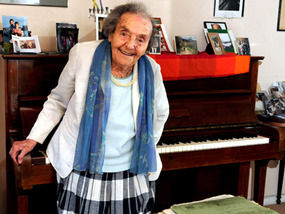
…Of course, according to this analysis, it’s obvious why Babbitt, Wuorinen, and others of their ilk don’t like this kind of analysis. It raises questions they’d rather not answer about what their own music is about. They seem to feel that constant dissonance is aesthetically neutral.
The idea, then, is that art that does not incorporate large dollops of pain, anguish, neuroticism,even madness, is inherently dishonest, or at best is escapism into the insanity of popular culture. Pain and Pleasure becomes entangled into an odd juxtaposition of S&M, where mutually exclusive forces engage in a symbiosis without resolution. The idea that Schoenberg music is aesthetically neutral, a collection of detached, and analyzable notes, holds equally, that the music is only aesthetic.
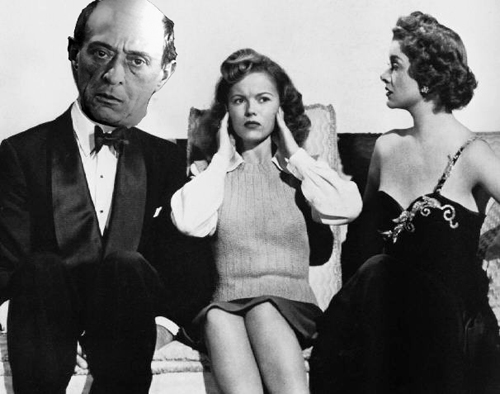
Read More: http://operachic.typepad.com/opera_chic/arnold_schoenberg/"One of Opera Chic's favorite pastimes in Vienna is to visit the Arnold Schönberg Center (they're so 1337 that they have a YouTube page full of videos and a fantastic MySpace page as well): Arnie, the greatest Austrian ever to move to California, gets lots of l0ve there from scholars, tourists tired of the usual visits to Schonbrunn and the Belvedere, and simple hangers-on (check out the library to see the cute very serious looking young aspiring composers who hang out there spying all those scores and wondering how they can make their stuff sound NOT like a wheezing washing machine)."
“Yet Alice found a way to survive the terror of the camps – a means to look beyond the horrors of day-to-day life in order to recall and cherish what was joyful, pure and noble about her fellow man. Alice survived through music… Still today, she speaks with great pride and passion of playing more than 100 concerts inside the concentration camp and she likens that experience, both for the performers and their imprisoned audience as being close to the divine. Alice is unequivocal in stating that music preserved her sanity and her life – while bringing hope into the lives of countless others. To this day Alice never tires of saying; “Music saved my life and Music saves me still.&
1;—Read More:http://www.nickreedent.com/Greg Sandow on reviewing a Schoenberg performance: “Even the weekend’s best performance, of Schoenberg’s first Chamber Symphony, had problems. Here we had a profound Schoenberg expert, Robert Craft, conducting 15 crack instrumentalists, who played with irresistible excitement. Their task, roughly speaking, was like climbing Mount Everest while dancing an intricate ballet. They gave us a feast of stunning detail, with each part in separate motion, combining to create a wonderful labyrinth that I doubt could be fully explored even if they’d played the piece for us a dozen times….
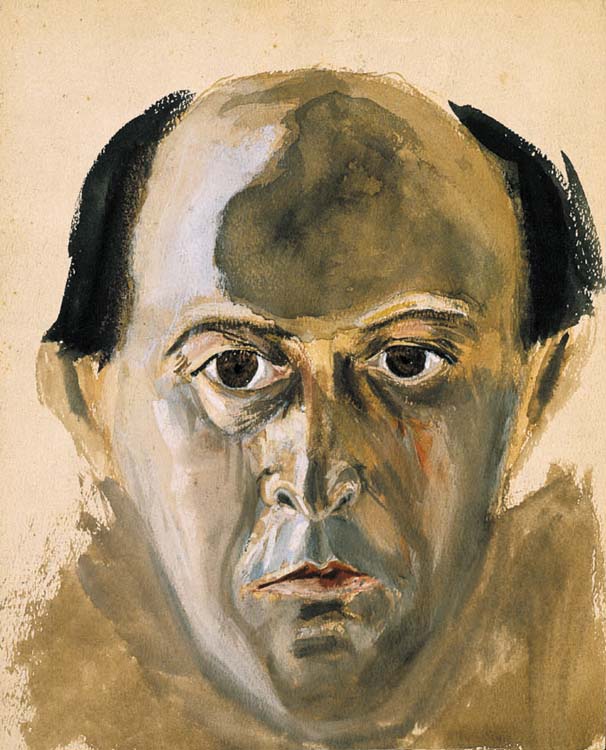
Schoenberg. Self portrait http://9qzp.jjli.gossip-celebrites.net/?PHPSESSID=hob7mm1fk694lhtrpn5f6dh4e1
…What was missing, though, was poetry. Schoenberg wrote the Chamber Symphony in 1906, before his atonal evolution. Much of it sounds like earlier composers, like Wagner or Mahler — or, rather, like a frighteningly intimate transformation of them. So why wasn’t it played with more of Wagner’s and Mahler’s emotion, turned ferocious by Schoenberg’s deeper exposure of himself? Read More: http://www.gregsandow.com/schoen.htm
… But a larger part, as a panel discussion afterward made clear, was the sheer difficulty of the work. James Levine, music director of the Metropolitan Opera, who loves this music, was a sympathetic participant. And as he and others said, musicians need to play music like this repeatedly, for many years, before they really learn it.
But then what’s the meaning of music that, even after nearly a century, still can’t be played? In 1859, when Wagner wrote his opera “Tristan und Isolde,” it too was unperformable. Yet in no more than 40 years it was mastered, at least to some extent, and even got popular. By contrast, Schoenberg’s Chamber Symphony — 92 years old, and not even as challenging as his later works — still eludes both performance and comprehension. Read More: http://www.gregsandow.com/schoen.htm a
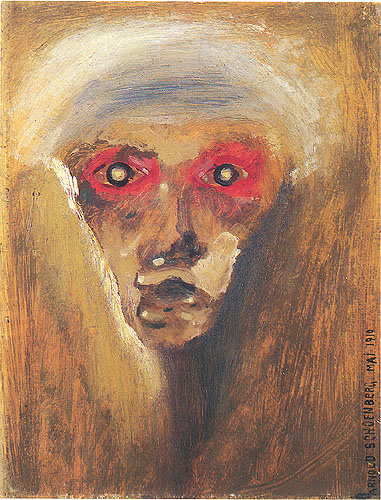
http://blog.eun.org/musica/2008/01/a_schoenberg_vision_rouge_clas.html Arnold SCHOENBERG, Vision rouge, 1910, huile sur carton, 35 X 25, Munich, Städtische Galerie im Lenbachhaus
Could Schoenberg put our broken century together, when nobody else could? Of course not. And because he so desperately tried, his music can sound awkward, at war with itself, and, like the Chamber Symphony, also fiercely private (which might explain why he didn’t mind making it so difficult to play). But Schoenberg’s current partisans seem never to consider this, even though Theodor Adorno, one of the most profound modern thinkers and an intense Schoenberg supporter, put such ideas on the table many years ago.Read More: http://www.gregsandow.com/schoen.htm
ADDENDUM:
So why did this Schoenberg retrospective bother me so much? Because, as so often happens when people who love this music talk about it, there’s no discussion of aesthetics. Schoenberg is talked about on one hand as if his music were totally abstract, just a collection of highly analyzable notes, and on the other hand as if it were just…well, nice, like something by Mozart, though obviously just a little more dissonant and complex….
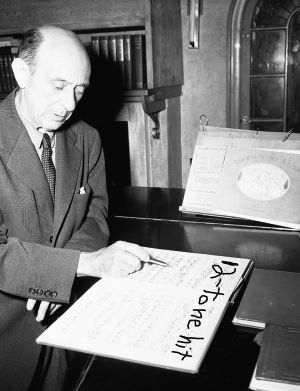
http://artsblog.ocregister.com/2008/04/16/schoenberg-no-1-with-a-bullet/1969/ “There is nothing I long for more intensely than to be taken for a better sort of Tchaikovsky. People should know my tunes and whistle them.” — Arnold Schoenberg
…But Schoenberg is more complicated than that. As I should have mentioned in my review, the symposium was titled Schoenberg: Conservative Radical, and that’s an apt label — or pair of labels — for a man whose music looks two directions at once. Schoenberg was, in his younger days, a revolutionary; later on, when he developed the 12-tone method, he became something of a neo-classicist. As a freely atonal composer (swimming, as he moaned later, in boiling water), he wrote — just for example — Pierrot Lunaire, a drunken little expressionist piece, and Erwartung, a fragmented abstract opera about a lost, confused woman who finds her lover’s corpse. Read More: http://www.gregsandow.com/schoen.htm
JOKES:
Freud wanted to explain the pleasure obtained from jokes. He thought it depended on their techniques as well as their tendencies. Techniques involve condensation, displacement, indirect presentation by means of allusion, plays on words, the breaking of ordinary burdensome rules of logic, and the establishment of unexpected connections between disparate ideas. It is this latter that Koestler (1964) calls “bisociation,” the coming together of lines of thought from different levels of the mind. The same process was depicted by Freud in 1900 in his “nodal points” of crossing lines of associations. These techniques are like those that operate in sexual foreplay. Foreplay derives from the diverse infantile roots of sexuality, the “component instincts.” In “harmless” jokes, the pleasure is like the “harmless” play with words in childhood and the more obvious forms of “harmlessness,” i.e., the supposedly non-sexual play of older children and adolescence. In “tendentious” jokes, which always have to do with more genitally organized erotic and aggressive sources, there is a sudden organization of the pregenital components into foreplay, with a surprising, even shocking, climax, an orgastic-like discharge. Such jokes allow access to ordinarily suppressed unconscious fantasies, and combine them with preconscious fantasies on other levels. The result is a discharge and a saving of energy equivalent, Freud thought, to the forces ordinarily maintaining the repression. “Harmless jokes,” according to Freud, resemble the non-orgastic play of children more directly. Read More:http://www.analysis.com/vs/vs85.html
What dreams, fantasies, humor, wit, symptoms, creative acts — what psychic acts have in common — is that all emanate from a psychic structure shared in qualitative essentials by almost all human beings. Following Waelder (1930), we would say that every psychic act obeys the principle of multiple determination and function. More specifically, what creative acts and jokes, and to a lesser extent, dreams, share is the sudden, shocking, joining, by the viewer or listener, of previously buried sexual and aggressive fantasies with fantasies more closely related to everyday, conscious perception.
But who makes up jokes? What impels them to do it? What are the dynamics of the creation of a work of art? Freud did not know, nor do we. In 1930, he remarked: “Even the best and fullest of them [biographies of great men] could not answer the two questions which alone seem worth knowing about. It would not throw any light on the riddle of the miraculous gift that makes an artist, and it could not help us to comprehend any better the value and effect of his works” (p. 211). However, we do understand more about the riddles of two internal, intrapsychic creations: the relative resolution of the oedipus complex and the reorganization of libidinal development in adolescence. Both resemble works of art: they bring together new conscious and unconscious possibilities in tangible forms. Both synthesize, organize, gratify, stabilize, serve adaptive purposes. Both involve the creation of new structures, the superego proper at the end of the oedipal period, and a new, adult-like ego ideal in mid-adolescence. The latter allows and combines genital orgasms and genital love, while repressing perverse fantasies or subsuming them under what we classify as foreplay. read More: http://www.analysis.com/vs/vs85.html
———————————————–
And it’s from music that Alice derives her supreme optimism. As she’s so fond of saying; “I have lived through many wars and have lost everything many times – including my husband, my mother and my beloved son. Yet, life is beautiful, and I have so much to learn and enjoy. I have no space nor time for pessimism and hate.” Read More:http://www.nickreedent.com/





 COMMENTS
COMMENTS